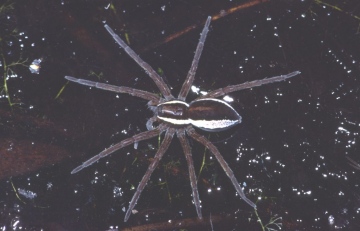Summary for Dolomedes fimbriatus (Araneae)
previous species | next species
National Distribution
Terms of Use. Double-click on map to go to region

Explore Regional Distribution
Please log on and add a note on this species
About this species
Recorded altitude range5m to 673m
Species text
DistributionThe species is widespread on southern heathlands, but very scattered elsewhere in Britain, north to Scotland. It is widespread in north-western and central Europe.
Habitat and ecology
Wet heathland, wet woodland, bogs. The main habitat of D. fimbriatus is Sphagnum bogs and pools, although juveniles may be found in much drier habitats away from bogs. The spider also inhabits water margins of ditches, ponds and slow flowing streams. Adults assume a hunting position on emergent water plants where the front appendages are held on the water surface. In this position the spider preys on invertebrates trapped on the water surface. When threatened the spider retreats underwater. Spiderlings hunt in high vegetation. Adults are found in spring and early summer. Females carry their spherical egg-sacs in their chelicerae and enclose them within a nursery web prior to spiderling emergence.
Status
Very local, but the spider may be not infrequent on some wet southern heathlands. No apparent decline.
Threats
The main threats are destruction of heathland for housing development and agriculture and the drainage of wetlands.
Management and conservation
Protect heathland sites from destruction and ensure the water-table of wetlands is maintained.
Text based on Dawson, I.K., Harvey, P.R., Merrett, P. & Russell-Smith, A.R. (in prep.). References
Adult Season
Habitats
background methodology
Recorded management for locations with Dolomedes fimbriatus
Recorded substrate and hydrology for locations with Dolomedes fimbriatus
Images
please log on and upload a new image for this speciesSee also A-Z Species Index - A-Z Picture Index - previous species | next species














